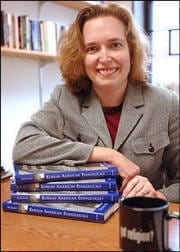Popular culture’s image of the 21st-century woman is tall, large-breasted, narrow-hipped and ultra-slender. Like cultural standards of beauty throughout history, today’s “thin ideal” is unattainable for most women; for many, it also can be destructive.
Katherine Presnell, assistant professor of psychology, is helping at-risk teens challenge this ideal with the Body Project, an eating disorder prevention program that she helped develop with psychology professor Eric Stice at the University of Texas at Austin, where she earned her doctorate in 2005.
 Since Stice conducted the first trial in 1998, more than 1,000 high school and college women, including 62 SMU students, have completed the program, including a research trial led by SMU Ph.D. students.
Since Stice conducted the first trial in 1998, more than 1,000 high school and college women, including 62 SMU students, have completed the program, including a research trial led by SMU Ph.D. students.
Independent studies conducted at universities nationwide and a recent analysis have shown that the Body Project significantly outperforms other interventions in promoting body acceptance, discouraging unhealthy dieting, reducing the risk of obesity and preventing eating disorders. And these results have persisted for three years.
Prevention is critical because about 10 percent of late-adolescent and adult female Americans experience eating disorder symptoms.
Katherine Presnell
Less than a third seek treatment, and less than half of those experience lasting results, says Presnell, director of SMU’s Weight and Eating Disorders Research Program in the Department of Psychology in SMU’s Dedman College.

While traditional interventions focus on education about anorexia, bulimia and binge eating, the Body Project is based on cognitive dissonance, which is the 1957 theory that inconsistent beliefs and behaviors create a psychological discomfort that motivates individuals to change their beliefs or behaviors.
While working with a patient who had anorexia during his postdoctoral studies at Stanford University, UT’s Stice says he asked her “to talk me out of being anorexic, and it was a very powerful exercise. Arguing against her own arguments caused her to rethink her perspective on her illness.”
Pictured right: Eric Stice
Body Project participants, recruited through fliers and mailings, argue and act against the thin ideal during four small-group sessions with a trained leader. They write letters to hypothetical girls about its emotional and physical costs, and challenge negative “fat talk” while affirming strong, healthy bodies.
“Many girls don’t question the messages we get from the media, the fashion industry, our peers and parents that it’s important to achieve the thin ideal at any cost,” Presnell says. “We have the girls critically evaluate the ideal, and that creates the dissonance they work to resolve.”
The Body Project includes a four-session weight management intervention that helps participants make small lifestyle changes to gain control over eating, such as scheduling time for daily exercise and a nutritious breakfast, and rewarding themselves with a book or bath rather than food.
“These little tweaks help participants maintain a healthy body weight and ward off unhealthy behaviors such as extreme dieting, fasting and self-induced vomiting to lose weight,” Presnell says. — Sarah Hanan
Related links:
Katherine Presnell
Weight and Eating Disorders Research Program
KERA: Interview with Body Project researchers
Reflections Body Image Program: Interview with Body Project researchers
The Body Project book
The Body Project workbook
SMU Department of Psychology
Dedman College of Humanities and Sciences
 According to the
According to the  A subsample of about 150 respondents will later be selected for more in-depth interviews, which will take place in 2009.
A subsample of about 150 respondents will later be selected for more in-depth interviews, which will take place in 2009.

 It is a discussion that seems familiar. But new findings show that people who travel frequently are more likely to experience déjà vu. Political liberals report more déjà vu experiences than conservatives do. And déjà vu becomes less common as people grow older.
It is a discussion that seems familiar. But new findings show that people who travel frequently are more likely to experience déjà vu. Political liberals report more déjà vu experiences than conservatives do. And déjà vu becomes less common as people grow older.